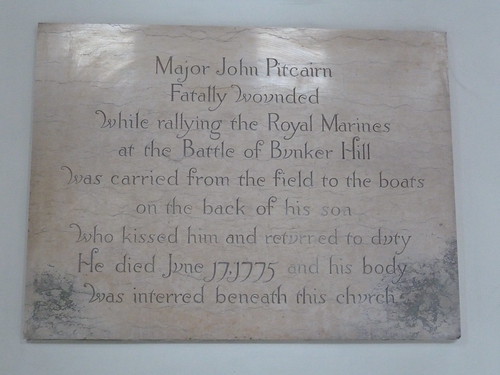Battle of Bunker Hill: June 17, 1775

Yesterday was the anniversary of the Battle of Bunker Hill. The battle is noteworthy because it was the first major engagement between the colonial militia and the British troops. Eight weeks earlier, an intense fight had occurred at Lexington, Concord and on the route back to Boston, but while those who participated in that engagement knew it was real combat, others – particularly many in England and those in the southern American colonies – viewed the April 19, 1775 episode as an unfortunate accident. Relations between England and the American colonies they believed could still be salvaged. After Bunker Hill, however, with its heavy casualties on both sides and the demonstrated willingness of the Americans to fight the British in a classic battle setting, the point of no return was passed and everyone became committed to an all-out war.
The plaque pictured above hangs in Boston’s Old North Church. It marks the death of British Major John Pitcairn who ironically was the on-scene commander of the British detachment that opened fire on the Lexington Minutemen on April 19. The plaque reads as follows:
Major John Pitcairn
Fatally Wounded
While rallying the Royal Marines
at the Battle of Bunker Hill
was carried from the field to the boats
on the back of his son
who kissed him and returned to duty
He died June 17, 1775 and his body
was interred beneath this church
During the British occupation of Boston, citizens respected Major Pitcairn more than any other British officer. From what I have read the respect he received from both his fellows soldiers and Boston residents is the reason he was buried beneath the Old North Church.
On April 19, 1775 as the British confronted the Americans on Lexington Green it was Pitcairn who ordered his soldiers not to fire on the rebels (at least that is what he wrote in his report to General Gage).